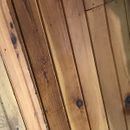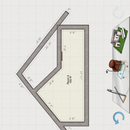Condensation at peak of vaulted/cathedral ceiling
I was wondering if I could get some advice regarding condensation on the vaulted ceiling in our bedroom. My wife and I purchased this house last fall (est. 1840, in Western NY) and have started to notice what looks to be condensation at the peak of our bedroom ceiling. It seems to come and go depending on the time of day. It’ll be dry in the morning and dripping by the afternoon, same results the past 2 days. I will try my best to describe the infrastructure:
One slope (west) of the ceiling is butted up against the roof rafters while the other slope (east) of the ceiling is up against the attic rafters. There is a portion of the master bedroom (south) where the ceiling is flat, which is adjacent to the attic slope. Access to the attic is through a man hole in the flat portion of the ceiling. This attic space runs the entire length of the house (north and south). The ceiling in our spare bedroom (north) is also vaulted with the same layout. (The provided picture is a cross-section of the upstairs of the house. Disregard the measurements labeled on the picture)
The first thing that comes to mind is poor attic ventilation. There are 4 “box” vents along the attic side of the roof. There is no ridge vent, no soffit vents. There are 2 gable vents, 1 on the north side and 1 on the south side. The south one is completely enclosed (for reasons unknown), obstructing any air in-flow from that vent. The north one is partially obstructed by a ceiling rafter. There is fiberglass insulation laid along the flat portion of the ceiling and up along the east facing ceiling slope. I don’t believe there is insulation on the west facing slope where the ceiling is up to the roof rafters. The previous owner did stuff insulation in the gaps where the ceiling starts down the western slope.
We have tongue and groove pine for ceiling material, which I know tends to be “leaky” in regards to air flow. The previous owner used what looks like black caulk around the creases and seams where the ceiling meets the wall, both up in the attic and in the actual room.
The roof seems to be in decent shape from an exterior point of view. I’m not sure how much of this issue is having a possible “leaky” ceiling, having poor attic ventilation or a combination of both. I’m also not understanding why the condensation is accumulating on the “cold”, or room side, of the ceiling. The attic is warmer, the bedroom is cooler (no AC). I figured condensation would accumulate on the warm, or attic side? I don’t see any signs of immediate moisture in the attic under insulation or around the ceiling rafters. There are colonies of white mold that have started to show up along the roof rafters in the attic, more so on the south side towards the gable vent that is completely closed off. I plan to do whatever work myself, and would like to address it ASAP.
Any tips or advice on which direction to go from here is greatly appreciated. I can provide more picture if need be.
GBA Detail Library
A collection of one thousand construction details organized by climate and house part











Replies
An easy diagnostic is to run a inward blowing window fan during sun hours. This will slightly pressurize the building and should stop infiltration of solar evaporated moisture.
Warm (ie solar heated) and wet areas create lots of water vapor. Summer stack effect (and sometimes wind) pulls this quickly into the house. It rises, so it accumulates in peaks. Condensation occurs when said water vapor gets colder (because it is now shaded from the sun).
I did prop open the hatch that leads into the attic and opened the windows in that room to hopefully create some inward air flow. The improvement of the condensation was minimal.
That's not at all the same thing.
Another option it to use a fan (say a ceiling fan blowing upwards) to mix/disperse/dilute the humid air accumulating in the peak
First, have you ruled out a roof leak?
To oversimplify, condensation occurs when warm moisture laden air comes in contact with a cool surface. If you don't have AC running, it's possible that you have high relative humidity in your home. When temps cool down at night, your pine ceiling cools and early in the day, when the stack effect kicks in that air rises, it hits the ceiling and condenses. But that's a theory for a mysterious problem. Have you read this? You're problem is not unique.
https://www.greenbuildingadvisor.com/article/summertime-condensation-near-peak-cathedral-ceiling
Yes, I have ruled out a roof leak. There is no immediate moisture in the attic above the location of the condensation.
It always helps to track moisture as best you can with both indoor and outdoor conditions; for when it is dry and when it is damp or wet.
Peter
Is there ANY air barrier at all behind that plank t & g ceiling? That's not a case of " ...tends to be..." leaky- it's EXTREMELY leaky. With no soffit to ridge venting to help purge moisture the roof deck ends up with VERY high moisture content by the end of the heating season in a zone 5A location!
Theory to investigate: Could it be that damp roof decking is being sun-baked, driving off moisture out of the roof deck creating extremely high moisture air in the rafter bays, with some of that air entering the cooler air conditioned side of the assembly to condense? (Probably. There could be more to it, but that's at least part.)
I do not believe there is any air barrier behind the t&g ceiling (at least on the east, or attic side). While up in the attic, I pulled back some of the insulation between the ceiling rafters to investigate. I turned off my light and did spot a tiny hole where light was coming through from the bedroom below. It was a associated with a knot in the t&g material.
Sorry for the delay in responses..
Out of curiosity the other day, I got up on a ladder and placed my hand on the ceiling ridge where the condensation is occurring. There is a clear void in the ridge where warm air is rushing into the bedroom. I couldn't believe the difference in temperature that was coming out of the attic and the temperature of the bedroom (still not air conditioned), it's very noticeable.
This is an area where the previous owner attempted to seal the ceiling ridge with that black caulk-looking material. I could easily reseal that area. I could also close the windows and place a dehumidifier upstairs (there is also one in the basement). Although these just seem like band aids or temporary fixes.
I can get up in the attic again this afternoon to take more pictures to give a better visual.
Also, there is noticeable paint peeling under the west side soffit. This is the side where the ceiling butts up against the roof. I will have to see if I have access to the soffits from up in the attic.
I was able to get high enough on a ladder and snap a picture of the ceiling peak/ridge. There is an obvious gap where there was an attempt to seal the seam. This is the same area where the condensation occurs.
Sounds like you have wet, warm are coming into the bedroom from the attic that is condensing on the cooler interior surface of the paneling. As Dana pointed out, without an air barrier behind the paneling, you don't have a situation where there may be some leaks, you simply have an incredibly leaky ceiling, Where you saw that light coming through, there was air moving through as well. On the side of the room with the attic, it would be possible to retrofit an air barrier and insulation, but where the paneling runs up the roofline, it would be a bit trickier. The good news is that taking down that paneling will be a lot less messy than if it were drywall and you'll have great access to do the work that needs to be done.